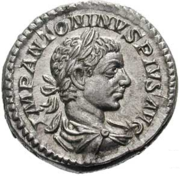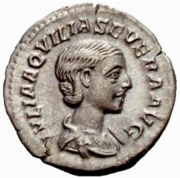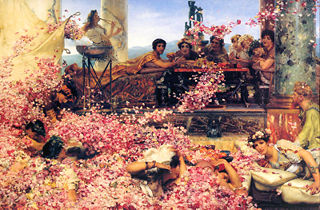Elagabalus
2008/9 Schools Wikipedia Selection. Related subjects: Ancient History, Classical History and Mythology; Historical figures
| Elagabalus | |
| Emperor of the Roman Empire | |
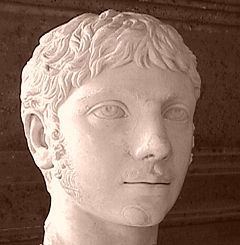 Bust of Elagabalus, from the Capitoline Museums |
|
| Reign | 218–222 |
|---|---|
| Full name | Varius Avitus Bassianus Marcus Aurelius Antoninus, known as Elagabalus |
| Born | ca. 203 |
| Died | 11 March 222 |
| Predecessor | Macrinus |
| Successor | Alexander Severus |
| Wives | Julia Cornelia Paula Julia Aquilia Severa Annia Faustina Julia Aquilia Severa Hierocles |
| Offspring | Alexander Severus (adoptive) |
| Father | Sextus Varius Marcellus |
| Mother | Julia Soaemias Bassiana |
Elagabalus (c. 203 – March 11, 222), also known as Heliogabalus or Marcus Aurelius Antoninus, was a Roman Emperor of the Severan dynasty who reigned from 218 to 222. Born Varius Avitus Bassianus, he was a Syrian by birth, the son of Julia Soaemias and Sextus Varius Marcellus, and in his early youth he served as a priest of the god El-Gabal at his hometown, Emesa.
In 217, the emperor Caracalla was murdered and replaced by his Praetorian prefect, Marcus Opellius Macrinus. Caracalla's maternal aunt, Julia Maesa, successfully instigated a revolt among the Third Legion to have her eldest grandson, Elagabalus, declared as emperor in his place. Macrinus was defeated on June 8, 218, at the Battle of Antioch, upon which Elagabalus, barely fourteen years old, ascended to the imperial power and began a reign that was marred by controversies.
During his rule, Elagabalus showed a disregard for Roman religious traditions and sexual taboos. He was married as many as five times and is reported to have prostituted himself in the imperial palace. Elagabalus replaced Jupiter, head of the Roman pantheon, with a new god, Deus Sol Invictus, and forced leading members of Rome's government to participate in religious rites celebrating this deity, which he personally led.
Amidst growing opposition, Elagabalus, only 18 years old, was assassinated and replaced by his cousin Severus Alexander on March 11, 222, in a plot formed by his grandmother, Julia Maesa, and members of the Praetorian Guard. Elagabalus developed a reputation among his contemporaries for eccentricity, decadence, and zealotry which was likely exaggerated by his successors and political rivals. This propaganda was passed on and, as a result, he was one of the most reviled Roman emperors to early historians.
Family
| Roman imperial dynasties | |||
| Severan dynasty | |||
| Chronology | |||
| Septimius Severus | 193 – 198 | ||
| -with Caracalla | 198 – 209 | ||
| -with Caracalla and Geta | 209 – 211 | ||
| Caracalla and Geta | 211 – 211 | ||
| Caracalla | 211 – 217 | ||
| Interlude: Macrinus | 217 – 218 | ||
| Elagabalus | 218 – 222 | ||
| Alexander Severus | 222 – 235 | ||
| Dynasty | |||
| Severan dynasty family tree Category:Severan Dynasty |
|||
| Succession | |||
| Preceded by Year of the Five Emperors |
Followed by Crisis of the Third Century |
||
Elagabalus was born in 203 as Varius Avitus Bassianus to the family of Sextus Varius Marcellus and Julia Soaemias Bassiana. His father was initially a member of the equestrian class, but was later elevated to the rank of senator. His grandmother Julia Maesa was the widow of the Consul Julius Avitus, the sister of Julia Domna, and the sister-in-law of emperor Septimius Severus. Julia Soaemias was a cousin of Roman emperor Caracalla. Other relatives included his aunt Julia Avita Mamaea and uncle Marcus Julius Gessius Marcianus and their son Alexander Severus. Elagabalus's family held hereditary rights to the priesthood of the sun god El-Gabal, of whom Elagabalus was the high priest at Emesa (modern Homs) in Syria.
The name El-Gabal originally referred to the patron deity of the emperor's birthplace, Emesa. El refers to the chief Semitic deity, while Gabal, meaning mountain (compare with the Hebrew gevul and Arabic jebel), is his Emesene manifestation. The god was later imported and assimilated with the Roman sun god, who was known as Sol Indiges in republican times, and later Sol Invictus during the 2nd and 3rd centuries. Avitus adopted the name of the god, being styled Elagabalus.
Rise to power
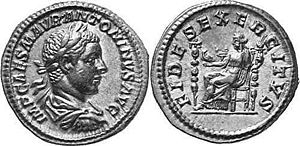
When the emperor Macrinus came to power he suppressed the threat against his reign by the family of his assassinated predecessor, Caracalla, by exiling them—Julia Maesa, her two daughters, and her eldest grandson Elagabalus—to their estate at Emesa in Syria. Almost upon arrival in Syria she began a plot, with her eunuch advisor and Elagabalus' tutor Gannys, to overthrow Macrinus and elevate the fourteen-year-old Elagabalus as emperor. Elagabalus and his mother readily complied and announced, falsely, that he was the illegitimate son of Caracalla, therefore due the loyalties of Roman soldiers and senators who had sworn allegiance to Caracalla. After Julia Maesa displayed her wealth to the Third Legion at Raphana they swore allegiance to Elagabalus. At sunrise on May 16, 218, Publius Valerius Comazon Eutychianus, commander of the legion, declared him emperor. To strengthen his legitimacy through further propaganda, Elagabalus assumed Caracalla's names, Marcus Aurelius Antoninus.
In response Macrinus dispatched his Praetorian prefect Ulpius Julianus to the region with a contingent of troops he considered strong enough the crush the rebellion. However this force soon joined the faction of Elagabalus when, during the battle, they turned on their own commanders. The officers were killed and Julianus' head was sent back to the emperor. Macrinus now sent letters to the Senate denouncing Elagabalus as the False Antoninus and claiming he was insane. Both consuls and other high ranking members of Rome's leadership condemned him, and the Senate subsequently declared war on both Elagabalus and Julia Maesa.
Macrinus and his son, weakened by the desertion of the Second Legion due to bribes and promises circulated by Julia Maesa, were defeated on June 8, 218 at the Battle of Antioch by troops commanded by Gannys. Macrinus fled toward Italy, disguised as a courier, but was later intercepted near Chalcedon and executed in Cappadocia. His son Diadumenianus, sent for safety to the Parthian court, was captured at Zeugma and also put to death.
Elagabalus declared the date of the victory at Antioch to be the beginning of his reign and assumed the imperial titles without prior Senatorial approval, which violated tradition but was a common practice among third-century emperors nonetheless. Letters of reconciliation were dispatched to Rome extending amnesty to the Senate and recognizing the laws, while also condemning the administration of Macrinus and his son. The Senators responded by acknowledging Elagabalus as emperor and accepting his claim to be the son of Caracalla. Caracalla and Julia Domna were both deified by the Senate, both Julia Maesa and Julia Soaemias were elevated to the rank of Augustae, and the memory of Macrinus and Diadumenianus was condemned and vilified by the Senate. The former commander of the Third Legion, Comazon, was appointed to be commander of the Praetorian Guard.
Emperor
First year
Elagabalus and his entourage spent the winter of 218 in Bithynia at Nicomedia, where the emperor's religious beliefs first manifested themselves as a problem. The contemporary historian Cassius Dio suggests that Gannys was in fact killed by the new emperor because he was forcing Elagabalus to live "temperately and prudently." To help Romans adjust to the idea of having an oriental priest as emperor, Julia Maesa had a painting of Elagabalus in priestly robes sent to Rome and hung over a statue of the goddess Victoria in the Senate House. This placed Senators in the awkward position of having to make offerings to Elagabalus whenever they made offerings to Victoria.
The legions were dismayed at his behaviour and quickly came to regret their decision to have him supported as emperor. While Elagabalus was still on his way to Rome, brief revolts broke out by the Fourth Legion, at the instigation of Gellius Maximus, and the Third Legion, which itself had been responsible for the accession of Elagabalus as emperor, under command of senator Verus. The rebellion was quickly struck down, and the Third Legion disbanded.
When the entourage reached Rome in the autumn of 219, Comazon and other allies of Julia Maesa and Elagabalus were given powerful and lucrative positions, much to the outrage of many senators who did not consider them to be respectable. After his tenure as Praetorian prefect, Comazon would serve as the city prefect of Rome three times, and as consul twice. Elagabalus tried to have his presumed lover Hierocles declared Caesar, while another alleged lover, Zoticus, was appointed to the non-administrative but influential position of Cubicularius. His offer of amnesty for the Roman leadership was largely honored, though the jurist Ulpian was exiled.
The relationships between Julia Maesa, Julia Soaemias, and Elagabalus were strong, at first. His mother and grandmother became the first women to be allowed into the Senate, and both received Senatorial titles: Soaemias the established title of Clarissima and Maesa the more unorthodox Mater Castrorum et Senatus. While Julia Maesa tried to position herself as the power behind the throne and subsequently the most powerful woman in the world, Elagabalus would prove to be highly independent, set in his ways, and impossible to control.
Religious controversy
Since the reign of Septimius Severus, sun worship had increased throughout the Empire. Elagabalus saw this as an opportunity to install El-Gabal as the chief deity of the Roman Pantheon. The god was renamed Deus Sol Invictus, meaning God the Undefeated Sun, and placed over Jupiter. As a sign of the union with the Roman religion, Elagabalus gave either Astarte, Minerva, Urania, or some combination of the three, to El-Gabal as a wife. He provoked further outrage when he himself married the Vestal Virgin Aquilia Severa, claiming the marriage would produce "god-like children". This was a flagrant breach of Roman law and tradition, which held that any Vestal found to have engaged in sexual intercourse would be buried alive.
A lavish temple called the Elagabalium was built on the east face of the Palatine Hill to house El-Gabal, who was represented by a black conical meteorite from Emesa. Herodian wrote "this stone is worshipped as though it were sent from heaven; on it there are some small projecting pieces and markings that are pointed out, which the people would like to believe are a rough picture of the sun, because this is how they see them". In order to become the high priest of his new religion, Elagabalus had himself circumcised. He forced senators to watch while he danced around the altar of Deus Sol Invictus to the sound of drums and cymbals, and each summer solstice he held a festival dedicated to the god, which became popular with the masses because of its widely distributed food. During this festival, Elagabalus placed the Emesa stone on a chariot adorned with gold and jewels, which he paraded through the city:
A six horse chariot carried the divinity, the horses huge and flawlessly white, with expensive gold fittings and rich ornaments. No one held the reins, and no one rode in the chariot; the vehicle was escorted as if the god himself were the charioteer. Elagabalus ran backward in front of the chariot, facing the god and holding the horses reins. He made the whole journey in this reverse fashion, looking up into the face of his god.
The most sacred relics from the Roman religion were transferred from their respective shrines to the Elagabalium, including the Great Mother, the fire of Vesta, the Shields of the Salii and the Palladium, so that no other God except El-Gabal would be worshipped.
Sex/gender controversy
Elagabalus' sexual orientation and gender identity are the source of much controversy and debate. Elagabalus married and divorced five women, three of whom are known. His first wife was Julia Cornelia Paula; the second was the Vestal Virgin Julia Aquilia Severa, but within a year, he abandoned her and married Annia Faustina, a descendant of Marcus Aurelius and the widow of a man recently executed by Elagabalus. He had returned to Severa by the end of the year, but according to Cassius Dio, his most stable relationship seems to have been with his chariot driver, a blond slave from Caria named Hierocles, whom he referred to as his husband. The Augustan History claims that he also married a man named Zoticus, an athlete from Smyrna, in a public ceremony at Rome. Cassius Dio reported Elagabalus would paint his eyes, epilate his hair and wear wigs before prostituting himself in taverns and brothels, and even the imperial palace:
Finally, he set aside a room in the palace and there committed his indecencies, always standing nude at the door of the room, as the harlots do, and shaking the curtain which hung from gold rings, while in a soft and melting voice he solicited the passers-by.
Herodian commented that Elagabalus pampered his natural good looks by wearing too much make-up. He was described as having been "delighted to be called the mistress, the wife, the Queen of Hierocles" and was said to have offered vast sums of money to the physician who could equip him with female genitalia. Subsequently, Elagabalus has often been characterized by modern writers as transgender, most likely transsexual.
Fall from power
By 221 Elagabalus' eccentricities, particularly his relationship with Hierocles, increasingly infuriated the soldiers of the Praetorian Guard. When Julia Maesa perceived that popular support for the emperor was quickly wavering, she decided that he and his mother, who had encouraged his religious practices, had to be replaced. As alternatives, she turned to her other daughter Julia Avita Mamaea and her son, the thirteen-year-old Severus Alexander. Convincing Elagabalus to appoint his cousin as his heir, Alexander was bestowed with the title of Caesar and shared the consulship with the emperor that year. However, Elagabalus reconsidered this arrangement when he began to suspect that the Praetorian Guard favored his cousin over himself. Following the failure of various attempts at Alexander's life, Elagabalus stripped his cousin of his titles, revoked his consulship, and circulated the news that Alexander was near death to see how the Praetorians would react. A riot ensued, and the guard demanded to see Elagabalus and Alexander in the Praetorian camp. The emperor complied and on March 11, 222 he presented his cousin, along with his mother Julia Soaemias. Upon arrival the soldiers started cheering Alexander, while ignoring Elagabalus, who ordered the summary arrest and execution of anyone who had taken part in this revolt. In response, the Praetorians attacked Elagabalus and his mother:
So he made an attempt to flee, and would have got away somewhere by being placed in a chest, had he not been discovered and slain, at the age of 18. His mother, who embraced him and clung tightly to him, perished with him; their heads were cut off and their bodies, after being stripped naked, were first dragged all over the city, and then the mother's body was cast aside somewhere or other, while his was thrown into the river.
Following his demise, many associates of Elagabalus were killed or deposed, including Hierocles and Comazon. His religious edicts were reversed and El-Gabal was returned to Emesa. Women were barred from ever attending meetings of the Senate, and damnatio memoriae—erasing a person from all public records—was decreed upon him.
Legacy
Historiography
A propaganda campaign against Elagabalus, traditionally attributed to Julia Avitus Mamaea, was instituted after his death. Many denigrating and false stories were circulated about him, and his eccentricities may have been exaggerated. The most famous among these, immortalized in the 19th-century painting The Roses of Heliogabalus, is that he smothered guests at a dinner to death with a mass of "violets and other flowers" dropped from above.
Augustan History
The source of many of these stories of Elagabalus's debauchery is the Augustan History (Historia Augusta), which scholarly consensus now feels to be unreliable in its details. The Historia Augusta was most likely written near the end of the 4th century during the reign of emperor Theodosius I, drawing as much upon the invention of its author as actual historical sources. The life of Elagabalus as described in the Augustan History is believed to be largely a work of historical fiction. Only the sections 13 to 17, relating to the fall of Elagabalus, are considered to hold any historical value.
Cassius Dio
Sources more credible than the Augustan History include the contemporary historians Cassius Dio and Herodian. Cassius Dio lived from the second half of the 2nd century until sometime after 229. Born into a patrician family, he spent the greater part of his life in public service. He was a senator under emperor Commodus and governor of Smyrna after the death of Septimius Severus. Afterwards he served as suffect consul around 205, and as proconsul in Africa and Pannonia. Alexander Severus held him in the highest esteem and made him his consul again. His Roman History spans nearly a millennium, from the arrival of Aeneas in Italy until the year 229. As a contemporary of Elagabalus, Cassius Dio's account of his reign is generally considered more reliable than the Augustan History, although it should be noted that Dio spent the larger part of this period outside of Rome and had to rely on second-hand accounts when composing his Roman History. Furthermore, the political climate in the aftermath of Elagabalus' reign, as well as his own position within the government of Alexander likely imposed restrictions on the extent to which his writing on this period is truthful.
Herodian
Another contemporary of Elagabalus was Herodian, who was a minor Roman civil servant who lived from c. 170 until 240. His work, History of the Roman Empire since Marcus Aurelius, commonly abbreviated as Roman History, is an eye-witness account of the reign of Commodus until the beginning of the reign of Gordian III. His work largely overlaps with Dio's own Roman History, but both texts seem to be independently consistent with each other. Although Herodian is not deemed as reliable as Cassius Dio, his lack of literary and scholarly pretensions make him less biased than senatorial historians. Herodian is considered the most important source on the religious reforms which took place during the reign of Elagabalus, which have been confirmed by modern numismatical and archaeological evidence.
Elagabalus in later art
Due to these stories, Elagabalus became something of a hero to the Decadent movement in the late 19th century. He appears in many paintings and poems as the epitome of an amoral aesthete. His life and character has inspired or at least informed many famous artworks, including the following:
Literature
- " William Wilson" (1839) by Edgar Allan Poe opens with an allusion to the wickedness of Elagabalus.
- L'Agonie (Agony) (1889), a novel by the French writer Jean Lombard
- The Sun God (1904), a novel by the English writer Arthur Westcott
- De Berg van Licht (The Mountain of Light) (1905), a novel by the Dutch writer Louis Couperus
- Algabal (1892–1919), a collection of poems by the German poet Stefan George
- The Amazing Emperor Heliogabalus (1911), a biography by the Oxford don John Stuart Hay
- St. Dorothy, a poem by Algernon Charles Swinburne, which refers to the saint's martyrdom under the emperor Gabalus
- Héliogabale ou l'Anarchiste couronné (Heliogabalus, or the Crowned Anarchist) (1934), an essay by the French surrealist Antonin Artaud
- Family Favourites (1960), a novel by the Anglo-Argentine writer Alfred Duggan
- Child of the Sun (1966), a novel by Lance Horner and Kyle Onstott, who were more famous for writing the novel behind the movie Mandingo.
- Super-Eliogabalo (1969), a novel by the Italian writer Alberto Arbasino
- Breakfast of Champions (1973), a novel by Kurt Vonnegut that mistakenly refers to Phalaris, a Sicilian tyrant, as Heliogabalus
- Boy Caesar (2004), a novel by the English writer Jeremy Reed
- Being an Account of the Life and Death of the Emperor Heliogabolus, a 24-hour comic by Neil Gaiman
Paintings
- The Roses of Heliogabalus (1888), by the Anglo-Dutch academician Sir Lawrence Alma-Tadema
- Heliogabalus, High Priest of the Sun (1866), by the English decadent Simeon Solomon, once a close friend of Algernon Charles Swinburne
Comics
- Vassalord (2006-), Nanae Chrono's Manga, where vampires are referred as "Heliogabalus of the hidden palace"
Music
- Eliogabalo, an opera by Venetian Baroque composer Francesco Cavalli (1667)
- Heliogabale, an opera by French composer Déodat de Séverac which premiered in 1910
- Heliogabalus Imperator (Emperor Heliogabalus), an orchestral work by the German composer Hans Werner Henze (1972)
- Eliogabalus, an album by rock band Devil Doll (1990)
- Six Litanies for Heliogabalus, by the composer and saxophonist John Zorn (2007)
- Elagabalus (as Heliogabalus) is mentioned in the " Major-General's Song" from the Gilbert and Sullivan opera The Pirates of Penzance: "I quote in elegiacs all the crimes of Heliogabalus."
- Heliogabale, a french rock band, a French rock band which has released five albums since 1995, among them "the full mind is alone the clear" recorded by Steve Albini in 1997
- Heliogabalus, a song by Momus from his 2001 album Folktronic, in which the narrator defends Heliogabalus, saying he "wasn't to blame" for the "deaths he caused"
Dance
- Héliogabale, a contemporary dance choreographed by Maurice Béjart
Film
- Héliogabale, a 1909 silent film by the French director André Calmettes
- Héliogabale, ou L'orgie romaine, a 1911 silent short by the French director Louis Feuillade
Plays
- Mencken, H.L. and Nathan, George Jean. Heliogabalus A Buffoonery in Three Acts. New York: Alfred A. Knopf, 1920.
- Elagabalus, Emperor of Rome (2008), a play by the American dramatist Shawn Ferreyra, which premiered in San Francisco, California, January 18 through February 2, 2008
- Escobar, C.H. de. "Heliogabalo: O SOL E A PÁTRIA". Ed. Devir. Rio de Janeiro. 1989.
Vocabulary
- The Spanish word heliogábalo means "person overwhelmed by gluttony".
